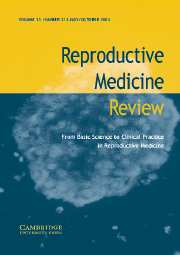Crossref Citations
This article has been cited by the following publications. This list is generated based on data provided by
Crossref.
Forti, Gianni
and
Krausz, Csilla
1998.
Evaluation and Treatment of the Infertile Couple1.
The Journal of Clinical Endocrinology & Metabolism,
Vol. 83,
Issue. 12,
p.
4177.
Ferraretti, A.P.
Gianaroli, L.
Magli, C.
Fortini, D.
Selman, H.A.
and
Feliciani, E.
1999.
Elective cryopreservation of all pronucleate embryos in women at risk of ovarian hyperstimulation syndrome: efficiency and safety.
Human Reproduction,
Vol. 14,
Issue. 6,
p.
1457.
Enskog, Anders
Henriksson, Malin
Unander, Margaretha
Nilsson, Lars
and
Brännström, Mats
1999.
Prospective study of the clinical and laboratory parameters of patients in whom ovarian hyperstimulation syndrome developed during controlled ovarian hyperstimulation for in vitro fertilization.
Fertility and Sterility,
Vol. 71,
Issue. 5,
p.
808.
Leibowitz, Deborah
and
Hoffman, Janet
2000.
Fertility Drug Therapies: Past, Present, and Future.
Journal of Obstetric, Gynecologic & Neonatal Nursing,
Vol. 29,
Issue. 2,
p.
201.
Davitian, C.
Uzan, M.
Hugues, J.-N.
Sifer, C.
Cédrin-Durnerin, I.
Wolf, J.-P.
and
Poncelet, C.
2005.
Hyperstimulation ovarienne : place de la chirurgie.
Gynécologie Obstétrique & Fertilité,
Vol. 33,
Issue. 9,
p.
718.
Selman, Helmy
Brusco, Gian Francesco
Fiorini, Fabrizio
Barnocchi, Nicoletta
Mariani, Monica
and
El-Danasouri, Imam
2009.
Vitrification is a highly efficient method to cryopreserve human embryos in in vitro fertilization patients at high risk of developing ovarian hyperstimulation syndrome.
Fertility and Sterility,
Vol. 91,
Issue. 4,
p.
1611.
Evbuomwan, Isaac
2013.
The role of osmoregulation in the pathophysiology and management of Severe Ovarian Hyperstimulation Syndrome.
Human Fertility,
Vol. 16,
Issue. 3,
p.
162.
Rinaldi, L.
Lisi, F.
and
Selman, H.
2014.
Mild/minimal stimulation protocol for ovarian stimulation of patients at high risk of developing ovarian hyperstimulation syndrome.
Journal of Endocrinological Investigation,
Vol. 37,
Issue. 1,
p.
65.


